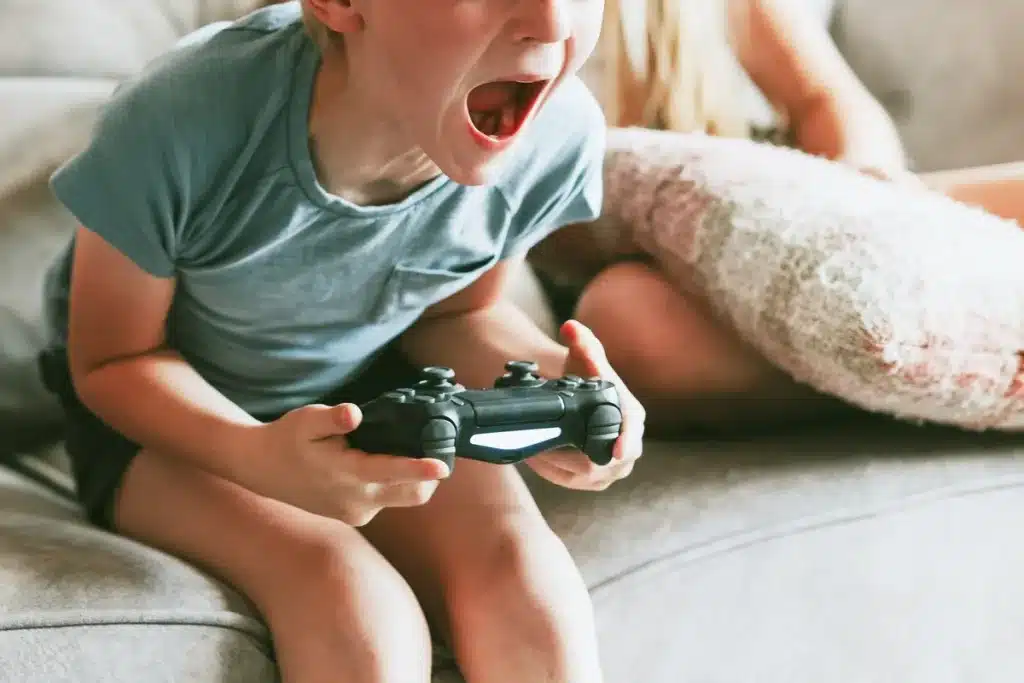Video game addiction in children is a growing concern in today’s technology-driven world. Once a harmless source of fun, gaming has evolved into something that, for some children, can become all-consuming. Parents and caregivers are often left feeling overwhelmed, unsure how to address the issue or even recognize the signs of addiction. In this article, we’ll explore ways to help children find a healthy balance between the gaming world and real life, fostering well-rounded development and healthy growth.
Understanding Video Game Addiction in Children
The virtual world of video games is filled with exciting opportunities for learning, creativity, and making connections with others. However, just like any other aspect of life, it needs to be balanced with care and awareness of its potential dangers.
Video gaming addiction, also known as gaming disorder, is recognized by many national and international health organizations as a real mental health condition. It can affect the brain and behavior in ways similar to other disorders or addictions. This reality makes it crucial for parents and guardians to be vigilant and take measures to protect their children from the negative effects of video game addiction. By setting limits, engaging in open conversations, and encouraging other healthy activities, they can help ensure that gaming remains a fun and constructive part of their children’s lives without taking over.
The Causes of Video Game Addiction
The allure of computer games is often in the carefully crafted reward systems that keep players engaged, leveling up, or obtaining new skills or items. The constant availability of these rewards, coupled with the brain’s response to them, creates a powerful incentive to keep playing.

Dopamine is a chemical in the brain that acts like a messenger, sending signals to different parts of the body. Imagine beating a challenging level in a game or defeating a gruesome monster. That victory feels great, right? That’s dopamine at work in your brain, giving you a “high five” for a job well done. Because winning in a game feels so good, thanks to the dopamine, kids might want to play more and more to keep getting that feeling. It’s like they found a candy machine that offers a chocolate bar every time a button is pressed – they will keep pressing it!
Probably the biggest contribution to developing gaming disorder comes from how parents view their child’s video game use. If they see it as just a normal part of growing up, like riding a bike or playing with friends, they might not realize the potential risks.
For some kids, gaming might fill a void, providing an escape from stress or feelings of loneliness. The virtual success and connections in games may mask real-world struggles, leading to overuse. Sometimes they are so hooked on computer games that they don’t seem to care about anything else. That’s how addiction can start. If a child plays video games so much that they forget about homework, friends, or even basic things like eating proper meals, that’s when the fun of gaming turns into a problem.
Recognizing Video Game Addiction Symptoms

Playing video games is a fantastic way to have fun and even learn new skills, but it should never take over everything else in a child’s life. Here are some warning signs that gaming might be turning into a problem rather than just a fun pastime:
- Ignoring school and home responsibilities: A child who used to be a good student starts getting lower grades, ignores schoolwork, or forgets to do chores because they’re always playing games.
- Putting up a fight when you take it away: If the child throws a tantrum or becomes unusually upset when not allowed to play, like crying when the gaming time is over, and the console is turned off.
- Promises to adjust or stop, but can’t: Despite knowing that gaming is affecting their life negatively, a child might try and fail to cut back on playing. This can surface withdrawal symptoms, create a cycle of anxiety and disappointment, further deepening the child’s reliance on the games as a way to escape those negative feelings.
- Lying about time spent gaming: This is a signal that the child views their gaming as something that needs to be hidden, possibly because they know that their playing time has gone beyond acceptable limits.
- Issues with personal hygiene and unhealthy eating habits: Showering, brushing teeth, or general grooming is ignored when a child is too engrossed in a game. At the same time, they may begin to neglect their diet; they might skip meals to continue playing or binge on unhealthy snacks for quick energy.
- Disturbed Sleeping Patterns: Video game addiction might lead to significant changes in a child’s sleeping patterns. For example, a child might stay up late into the night playing games, leading to a lack of sleep and difficulties in waking up for school the next morning.
Effects of Video Game Addiction
Many school children today are drawn to the colorful worlds of video games like “Minecraft,” “Fortnite,” “Roblox,” and “Among Us.” These games provide an opportunity for creativity, strategic thinking, and collaboration with friends online. Whether building complex structures in “Minecraft” or embarking on exciting missions in “Fortnite,” kids engage with these virtual landscapes, finding joy and challenge in gameplay. These games have become a common topic of conversation and a shared experience for many young gamers.
While these games captivate kids with their engaging gameplay and vibrant graphics, there can be a downside. Excessive playing might lead to addiction, where the games become a compulsive need rather than a fun activity. Like too much of a good thing, overindulgence in these virtual worlds can impact sleep, social interactions, and even school performance. Whether dealing with a young child enchanted by colorful pixels or a teenager engrossed in an online quest, the emotional toll of gaming addiction can be significant.
👉 Curious about the connection between your child’s restlessness and the negative effects of video games? Dive into our article to uncover insights and solutions.
Impact on Little Kids: Hindering emotional development

For our youngest gamers, video games can be both an exciting world of exploration and a potentially harmful distraction. When a child plays excessively, the appeal of building virtual worlds might overshadow the need for real-life learning and play. At this tender stage of development, their brains are growing and adapting rapidly. Too much gaming might limit their understanding of how to handle stress and emotions outside the digital realm.
The craving for instant rewards in the game can translate into impulsivity in real life. If a child is used to getting virtual coins or achievements right away, waiting for a treat or even taking turns in a game with friends at school might become difficult. The ability to delay gratification, which is essential for self-regulation and long-term planning, might decrease.
Impact on Teenagers: Taking a toll on social development

Teenagers face different challenges with gaming addiction. High school can be a time of self-discovery and building friendships, but for those immersed in games, the focus on virtual battles might pull them away from these critical real-life experiences. Think about a teenager who spends hours perfecting their virtual avatar or account on social media, but struggles to engage in a simple conversation at the dinner table. This behavior can lead to missed opportunities to grow socially, much like skipping classes might lead to gaps in education. Adolescents might find themselves feeling isolated and disconnected from their peers, unable to form the relationships that are so vital at this stage of life.
Is There a Link Between Compulsive Gaming and ADHD?
The short answer is NO. Although it’s not apparent from the start, ADHD is a condition a child is born with. It’s thought to be hereditary, which means it can run in families. Another possible onsetting factor is prenatal exposure to harmful substances like drugs, tobacco, radiation, or heavy metals.

Compulsive gaming – or gaming disorder – is a mental health condition that can mimic ADHD symptoms like irritability, short attention spans, and forgetfulness. These are the symptoms that usually alert parents and make them mix the two. When kids play video games a lot, they can become hyperfocused on the game and lose touch with what’s going on around them. They might seem distracted and restless and have trouble controlling their impulses, things that are also common in children with ADHD.
Another scientific fact that links the two is that children that are previously diagnosed with ADHD are more likely to develop a video game addiction. This can be worrying, especially since kids with ADHD often find it hard to concentrate for long periods. This shows how addictive video games can be and how they can influence brain connections to keep children hooked.
In 2019, the World Health Organization (WHO) decided to classify gaming disorder as an addiction. This means that some people can become so involved with video games that it starts to interfere with their daily activities. The American Psychiatric Association also considers internet and gaming disorder (IGD) to be a mental health problem. This puts it in the same category as gambling and substance abuse, like drug or alcohol addiction.
Read more and delve deeper into the link between children’s restlessness and video games, and you’ll gain a clearer understanding of how excessive gaming can affect your child’s behavior.
How to Stop Video Game Addiction in Your Child
Excessive gaming is like a small leak in a boat; if left unattended, it can turn into a significant problem. Parents, guardians, and educators must be vigilant and informed about the potential effects that too much gaming can have on a child’s development.
At first, an extra hour or two might not seem like a big deal. But over time, if that excessive gaming isn’t addressed, the child might start to neglect homework. Friends might be ignored, and social skills might begin to falter. Personal hygiene and proper sleep might also be affected. Understanding that video games can be more than just a pastime, recognizing signs of addiction or unhealthy behavior, and taking appropriate measures is essential.
1. Start with empathy
Playing video games is something children enjoy, and they won’t give it up easily. When you start with empathy, you validate this fact and become more approachable. Say something like: ‘I understand why you like games so much; they are really fun. I know a lot of kids who play. I also know that sometimes kids overdo it. Should we check to see if you’re ok?’ With this approach, children are more likely to open up to talk about it rather than withdraw out of guilt or shame. Always be aware that punishments or a harsh approach won’t fix the behavior and might even perpetuate it. You can make your house technology-free, but children might still find a way to get some video game time elsewhere.
2. Clear and Consistent Limits for Screen Time
Setting clear and consistent limits on screen time is vital. This includes time spent on video games for leisure and screen time for schoolwork. Create a schedule and set limits that balance playtime, study time, family time, and other activities. For example, you might establish rules like “No video games until homework is done” or “Only one hour of gaming on school nights.” Consistency is key here, so ensure that everyone involved in the child’s care is on board with the rules.
3. Take Content Seriously
It’s not just the amount of time spent playing that matters, but also the content of the games. Some games can be violent or include themes that are inappropriate for children, potentially leading to behavioral problems. Familiarize yourself with the content of the games your child is playing. Discuss with them what’s acceptable and why, and consider using parental controls to block inappropriate content. Understanding the gaming world helps you make informed decisions about what your child is exposed to.
4. Talk About Facts in Age-Adapted Language
It’s essential to talk openly about video game addiction, but in terms children can understand. Explain how the brain responds to video games, likening it to a reward system that makes them want to play more. Discuss how this lack of control over playing can develop into addiction, just like other forms of addictive behavior. Use simple terms and analogies, like comparing the craving for more gaming to craving sweets. By making the information accessible, you’re empowering your child with knowledge to recognize the signs of video game addiction and make conscious efforts to control their gaming habit.
5. Encourage alternative activities
Hobbies and interests that can replace excessive gaming. Here’s where you can get creative and tap into your child’s other interests. If they love the strategy involved in gaming, perhaps they would enjoy chess or puzzle-solving. If they enjoy the adventure aspect of the gaming world, exploring outdoor activities like hiking or joining a sports team might be appealing. Encourage reading, art, music, or other constructive hobbies that can enrich their real-world experience. Create family activities that involve everyone, making the transition from the gaming world to the real world more engaging and enjoyable.
Parental Involvement in Overcoming Excessive Gaming
Sometimes the problem starts with the grown-ups at home. Many of us work on our computers, tablets, or phones, and our kids see that. They watch us with screens all the time, and it’s not always easy for them to understand why that’s different from playing video games. When kids see adults using technology a lot, they might wonder, “Why can they use screens and I can’t?” It’s a tough question, especially when we need to explain that work is different from play.
This situation makes it even more essential for parents and other adults to talk openly with kids about why we use screens and to set clear rules. We need to show them that, yes, sometimes we need technology for work or other responsibilities, but that doesn’t mean screens should take over our lives.

Creating a Supportive Home Environment
The gaming console isn’t the enemy; it’s a part of modern life that can be enjoyed in healthy doses. Establishing guidelines for screen time starts with having a friendly chat with your child. You might agree that an hour or two of video game play is okay after homework is done, but not before. Explain that the rules aren’t there to take away fun but to make sure that other important things like school, family time, and outdoor activities should be prioritized.
👉 Wondering if parents should limit screen time? Explore our article for valuable insights and guidance. Read “Should Parents Limit Screen Time? How to Avoid Turning Screens into “the Babysitter”, in 3 steps” to reclaim quality family time!
Building Resilience and Coping Skills
As with any other addiction, video game addiction can be pretty scary, especially when it involves children. Addictions often reflect the state of a person’s emotional state. If a child is feeling stressed about schoolwork or having problems with friends, they might turn to a video game where they can be a hero, solve problems easily, or simply switch off from their real-life troubles. Video games become an escape.
Creating a supportive environment for children is vital in teaching them to be resilient and develop healthy coping skills. A resilient, emotionally strong child is less likely to develop unhealthy screen time habits. Here’s what parents can do and say to help:
- Encourage Open Communication: Create regular family talk time, such as during dinner or before bedtime. This wil sent the message ‘I’m here for you. You can always talk to me about anything, and I will listen’
- Promote Problem-Solving: Encourage the child to find solutions to their problems. Teach them that ignoring problems won’t always make them go away and the importance of sorting things out early.
- Model Healthy Coping Strategies: Share your own strategies for dealing with stress, like reading a book, taking a walk, or deep breathing. If it’s also video grames or internet browsing, tell them how you manage to keep a balance.
- Teach Them to Ask for Help: Show them that it’s okay to ask for assistance from family, teachers, or friends. Remind them that asking for help is a sign of responsibility, not weakness.
Seeking Professional Help
When dealing with children’s video game addiction, it’s crucial to recognize when professional intervention may be necessary. If a child exhibits persistent behavioral changes, withdrawal from social activities, decline in academic performance, or severe preoccupation with gaming, consulting a mental health professional who specializes in pediatrics and child behavior is essential. The right professional to consult may vary depending on the child’s specific needs and the severity of the behavior. This could include child psychologists, behavioral therapists, or counselors specializing in addiction.
Parents should also work closely with schools and other caregivers who know the child well. This means talking with teachers, counselors, peers, and other members of the family so everyone understands the problem and works together to help.
Conclusion
Video game addiction in children is a concern that many adults face, but it’s a challenge that can be met with understanding and thoughtful strategy. It’s about recognizing the appeal of video games and balancing that with other enriching activities and responsibilities.
Communication is key: openly discussing the matter, setting clear guidelines, and exploring alternative interests together. The goal isn’t to villainize video games or shame the child but to foster a well-rounded lifestyle where gaming is a part of life, not the entirety of it. With patience and collaboration, adults can help guide children to find joy, achievement, and fulfillment both in the gaming world and in real life.
Join us for ‘Why Screens Harm Your Child: 5 Steps to Get Your Kid Off Tablets, Phones & TV.’ This online event offers a balanced look at screen time and provides practical strategies to guide your child toward a healthier digital lifestyle. Connect with experts and parents, and discover how to beat video game addiction. Reserve your spot today!
Have a question right now? Click here to start a conversation with Sophie, our friedly AI assistant and find support tailored to your unique parenting journey.
References
American Psychiatric Association. (n.d). Internet Gaming. https://www.psychiatry.org/patients-families/internet-gaming
Darvesh, N., Radhakrishnan, A., Lachance, C.C., Nincic, V., Sharpe, J.P., Ghassemi, M., Straus, S.E. & Tricco, A.C. (2020). Exploring the prevalence of gaming disorder and Internet gaming disorder: a rapid scoping review. Systematic Reviews, 9(68). https://doi.org/10.1186/s13643-020-01329-2
Griffiths, M. D. (2016). Gaming addiction and internet gaming disorder. In R. Kowert & T. Quandt (Eds.), The video game debate: Unravelling the physical, social, and psychological effects of digital games. 74–93. Routledge/Taylor & Francis Group.
Haghbin, M., Shaterian, F., Hosseinzadeh, D., & Griffiths, M. D. (2013). A brief report on the relationship between self-control, video game addiction and academic achievement in normal and ADHD students. Journal of Behavioral Addictions, 2(4), 239-243. https://doi.org/10.1556/jba.2.2013.4.7
Lee, J., Chou, C., Chou, J., Huang, W., Kuo, C., Lee, Y., & Wang, J. (2018). Heavy Metals’ Effect on Susceptibility to Attention-Deficit/Hyperactivity Disorder: Implication of Lead, Cadmium, and Antimony. International Journal of Environmental Research and Public Health, 15(6). https://doi.org/10.3390/ijerph15061221
Li, K., Chen, H., Ferber, J. R., Hirst, A. K., & Odouli, R. (2020). Association Between Maternal Exposure to Magnetic Field Nonionizing Radiation During Pregnancy and Risk of Attention-Deficit/Hyperactivity Disorder in Offspring in a Longitudinal Birth Cohort. JAMA Network Open, 3(3). https://doi.org/10.1001/jamanetworkopen.2020.1417
Mathews, C.L., Morrell, H.E., & Molle, J.E. (2019). Video game addiction, ADHD symptomatology, and video game reinforcement, The American Journal of Drug and Alcohol Abuse, 45(1), 67-76. https://doi.org/10.1080/00952990.2018.1472269
Nasution, F. A., Effendy, E., & Amin, M. M. (2019). Internet Gaming Disorder (IGD): A Case Report of Social Anxiety. Open Access Macedonian Journal of Medical Sciences, 7(16), 2664-2666. https://doi.org/10.3889/oamjms.2019.398
World Health Organization. (n.d). Gaming Disorder. https://www.who.int/standards/classifications/frequently-asked-questions/gaming-disorder








